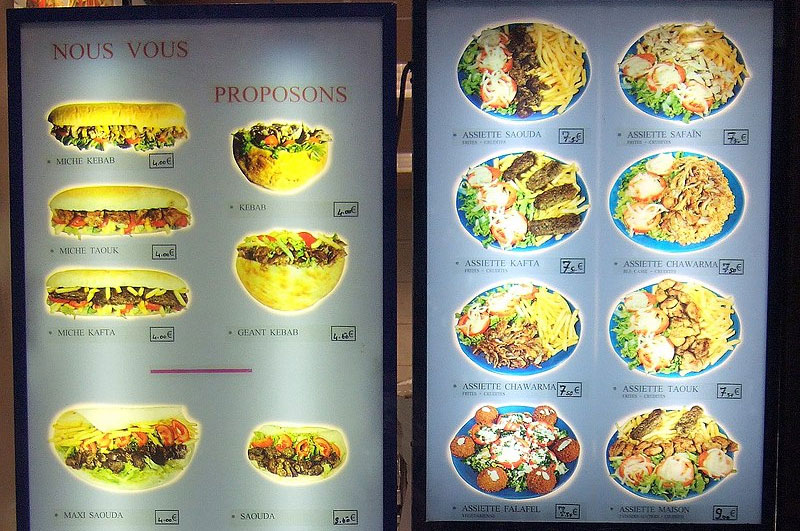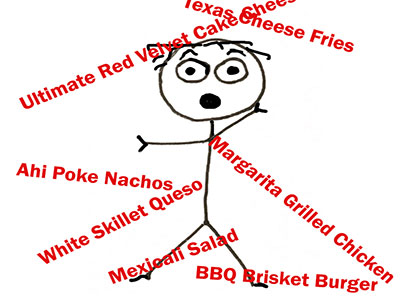
Recently, I was on the road and saw a sign for a restaurant reading, Just Like Mom’s Restaurant: Coming Home to Mom’s Never Tasted So Good. The paradox of this sign (just like Mom’s but also better than Mom’s?) cracked me up, and the more I thought about it, the more amused I felt.
Get a free sample proofread and edit for your document.
Two professional proofreaders will proofread and edit your document.
Curious, I read reviews of the restaurant, which were actually really good, but the sign got me thinking about how often restaurant signs have strange or confusing names or taglines, joyless or difficult to interpret logos, misspellings or other basic errors, and other problems that might repel rather than attract customers.
Later on the trip, I was looking at some online menus to find a place en route my fellow traveler and I could stop to grab a bite. This prompted another realization: There are lots of terrible menus out there. So, restaurateurs everywhere, today’s blog about effective menu design, language, and other considerations, is for you.
I’ve certainly had my share of experiences with menus where it takes some intense study to navigate the chaotic information and design. Menus should be easy to read, so the #1 consideration when writing a menu is layout. Depending on what your restaurant offers, categories may vary, but most menus would include (in approximately this order): appetizers (starters, small plates), main courses (may be subdivided into handheld and knife-and-fork meals), side dishes, beverages, and desserts. It can be helpful for a restaurant that serves alcohol to have a separate drink menu so customers can make that decision before turning to decisions about food.
In addition to layout, design encompasses the menu’s overall style including font type and size as well as logo, graphic/image, and photographic content. It’s important to note that photographs of food taken without care for lighting, plating, and other aesthetic elements may be highly unappetizing; consider the fact that there are professional food photographers for a reason, and question whether photographs of your restaurant’s dishes are even necessary.
Regarding font, logos, style, and layout, consider that there are also professional menu designers, and this too is not a simple task. A general suggestion is to err on the side of simple, clean, tasteful fonts, images, and colorful elements to keep distraction from the content of the menu to a minimum. One special note: avoid fancy fonts customers may find difficult to read.
It’s critical to focus on your customers’ ability to easily access the information your menu is presenting. Use language that is clear but descriptive, and if you’re using industry terms that may not be well-known, consider other wording, clarify word meanings in the text of menus where possible, and prepare waitstaff to be ready to explain meanings of menu descriptions that may not be immediately transparent.
It’s good to use specific adjectives to bring foods to life on your menu. Describing vegetables as charred, butter-sauteed, wilted, or lightly-sauced conjures up a more specific image of the eating experience and helps your customers make choices they’ll be excited about choosing and happy eating. Being specific in the types of ingredients and origins of foods like wagyu beef and herbs de Provence adds authenticity and interest as well.
Perhaps, considering that this is a proofreading company’s blog, it goes without saying, but hiring a professional proofreader for your menu is strongly advised. Errors in spelling, grammar, and punctuation, as well as challenges to clarity, interfere with a menu’s effect and can be so easily avoided by using a quality proofreader in the finishing stages of the project.
Sometimes it is nice to include information on the menu beyond the food selections, such as a little history of the place if it’s interesting and/or relevant; the chef’s name and bio, if impressive; or the restaurant’s mission and vision, if significant. Keep such information brief and position it so that it’s not a distraction from the main content of the menu.
Another consideration is the number of choices on a menu. This varies greatly depending on the culinary level of a restaurant; a restaurant with a trained, visionary chef generally tends to have a more select menu. If your restaurant is casual, try to keep the number of items in check. I’ve definitely seen menus that read like nineteenth-century Russian novels (Can you say “The Cheesecake Factory“?), and the task of making a selection can be daunting.

One more thought about how many items to include (Full transparency here: I’m a vegetarian.) is to consider having one, two, or more thoughtful vegan or vegetarian-with-vegan-substitutions available meal options on your menu (French fries, though generally vegan and delicious, are not what I call “thoughtful” or a “meal.”) Such items will satisfy more than just vegans and vegetarians as religious restrictions may involve meat or dairy. Making transparent which menu choices include foods people often have allergies and sensitivities to (e.g., nuts, dairy, gluten, shellfish) is also a great idea.
Providing your customers with their choices in a well-organized, stylish, descriptive, informative, and pleasing-to-touch (i.e., clean) form, in combination with providing food that’s delicious will keep customers coming back and positive reviews coming in.
Sarah P.
Get a free sample proofread and edit for your document.
Two professional proofreaders will proofread and edit your document.
Get a free sample proofread and edit for your document.
Two professional proofreaders will proofread and edit your document.
We will get your free sample back in three to six hours!